Slow evolution of a side garden
Here’s why, years ago, I started taking pictures of my yard, despite the likelihood of looking cuckoo to the neighbors while snapping away at stretches of lawn or barely there, newly planted beds: it’s fun to go back later and see how things have changed. Changes need not include high-dollar hardscaping or significant replanting in order to be appreciated either. Just seeing how much your trees have grown can be eye-opening. Through regular photo-taking you can study a moment frozen in time, and then skip ahead to the next year — so different from the day-to-day experience of a garden’s infinitesimal growth or even the slow creep of seasonal change.
I dug up old pictures of my front side yard this morning, the last area of my garden that’s been converted from lawn. Here’s how it started: a big swath of St. Augustine grass from the back yard all the way up to the street. At this point I’d already added the curbside garden along the street; this is a winter view after its first season, I think. Not too much going on.
In January 2012 I hired a landscaper to lay a decomposed-granite path that runs from the back gate (our vantage point) uphill toward the street, where it makes a Y. To the right it runs to the street between my yard and my neighbor’s; to the left it follows the curve of the curbside garden and leads to the driveway. This stretch is 4 feet wide. I’d have preferred 5 feet of width, but I was trying to minimize any damage to live oak roots in this narrow space between my yard and my neighbor’s. (The path widens to a generous 5 feet behind the curbside bed.)
I used economical steel landscape edging to keep the gravel in place and grass out. Stone would been preferable, but my budget ruled that out. Two shallow limestone steps help tame the slope and slow water runoff during our Texas thunderstorms. I’ve never had any wash-out of gravel on this path.
A year later, in March 2013, I was ready to dig out the remaining grass and plant. In the skinny strip along the right side of the path, I initially hoped to establish a spaced out hedge of ‘Will Fleming’ yaupons to screen the neighbor’s driveway and provide a sense of enclosure. To save money, I filled the remaining space with divisions from existing plants, mostly dappled-shade-tolerant grasses for low maintenance and good deer resistance: inland sea oats (Chasmanthium latifolium), variegated miscanthus (that straw-colored lump to the right of the live oak in the foreground), and bamboo muhly (Muhlenbergia dumosa).
And here it is as of this morning. The grasses are filling in vigorously, and I’ve recently added Aztec grass to brighten the narrow strip at right. But the biggest change is, obviously, the lattice fence, which I had constructed in May. The ‘Will Fleming’ yaupons, much as I love them, just weren’t going to provide the enclosure and screening I wanted for a few years, and I continually worried that the deer would antler them to pieces in autumn.
So I sprung for the fence and am so glad I did. It instantly created an intimate garden space in an otherwise throwaway part of the yard, and yet it’s friendly, not standoffish, with breeze- and light-admitting, 5-inch-square lattice openings. Live oaks arch over this space — as they do all of my garden — and create a leafy ceiling. At the Y in the path ahead, a possumhaw holly (Ilex decidua) is slowly growing and will one day be a graceful, red-berried focal point as you walk up the path.
Turning around, here’s the Heart Gate to the back garden, offering a peek-a-boo view of a Yucca rostrata, with a higher view of ‘Blue Ice’ Arizona cypress visible through the arbor. I think I may paint the water-stained fence boards on this side of the gate. What color, do you think? Could I get away with not painting the lattice above, half of which is buried under a butterfly vine? I think I also need to elevate the silver pot of Nolina lindheimeri with a couple of concrete squares, and maybe add another pot.
All in good time. This side garden has been evolving at a Darwinian pace for 5 years. Still, one day I’m sure I’ll look back at these pictures and think, Now why didn’t I get around to [pick a project] sooner?
All material © 2006-2014 by Pam Penick for Digging. Unauthorized reproduction prohibited.


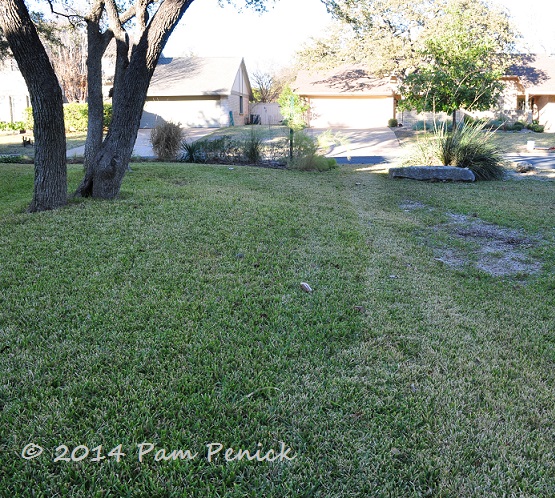
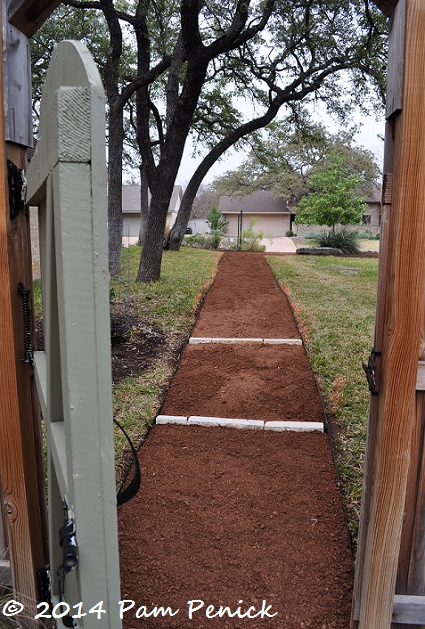
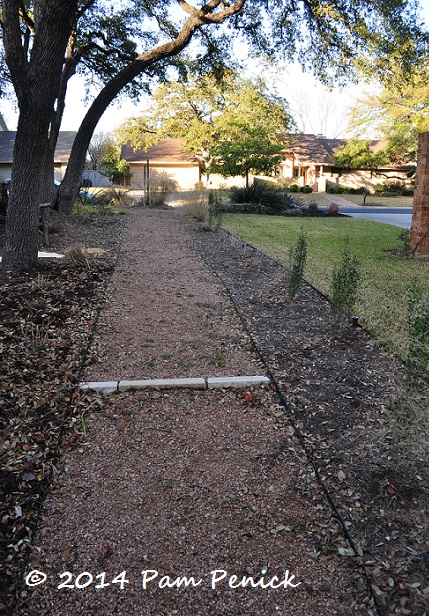
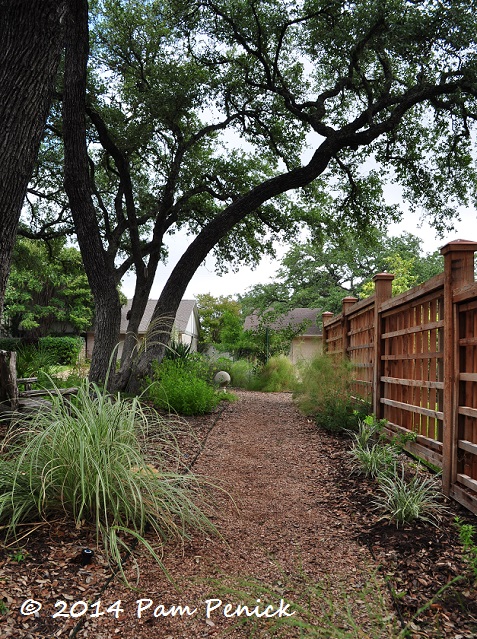
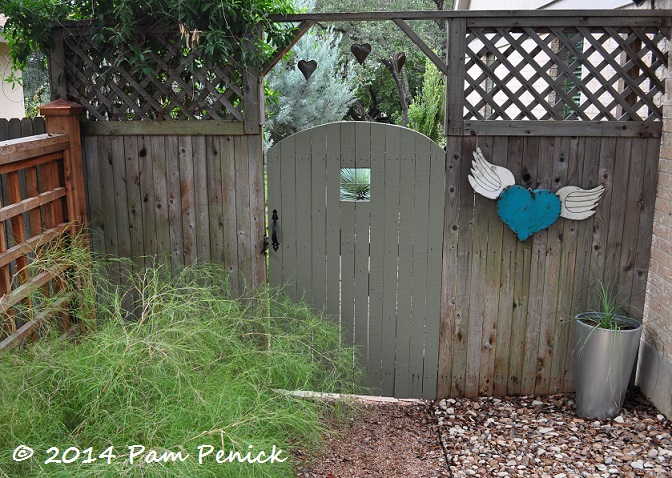
This is evolving at the same stately pace as my garden, Pam. It is excruciating, but I think it results in a better garden than a formal design, rigidly followed and quickly done, would. Yours is a case in point; it’s superior in every way. Beautifully photographed, too. I envy your talent with a camera.
A stately pace is an excellent way of putting it, Peter. It sounds so regal! My pace is driven by budget and energy, but the design has been in my head for a while. I find it hard to wait, but it never hurts to have more time to think about something before plunging in. —Pam
My vote is to paint both fence and lattice, and a color darker and less saturated than the gate so the focus stays on the gate. I know you’re shocked. 😉
Totally shocked, Lori. 🙂 I like your suggestion for the outside, but I really, really don’t want to get into fence painting on the inside, and I worry that with the lattice it’ll bleed over or show a bit on the other side if I only paint the front. Will have to think about this a bit more, and maybe experiment on a spare piece of lattice. —Pam
And adding the fence really did make a dramatic difference in the feel of the space. I really like how it’s coming together!
Thanks, Lori. A fence is such an instant result. The poor yaupons didn’t stand a chance. —Pam
I can’t believe you have been there 5 years already. I have found since I started photographing the garden for the blog that I see things better, you look more closely.
I think you could get away without painting the trellis if you matched the side panels to the gate. Although I am concerned about the hanging hearts above the gate as you are all so tall don’t you knock them all the time?!
Six years this October, Helen, although I didn’t start gardening in this part of the yard for at least a year. As for your concern about my head, well, as you know I AM quite tall. But for perspective the green gate is 6 feet tall. Lots of room there! —Pam
Since discovering your blog, 5 years ago, I’ve started to take photos every May 15th of my yard.
The house had little landscaping and as time passes, I can watch as my Arizona cypress grow each year or Century Agaves go from 12″ tall to 3′ tall.
It has helped “reinforce” simple concepts too. When I planted the agave my (wiser) wife said “give it room… It’s mom was as big as a VW bug”. I thought… “Humbug… That can’t be true…”
Now I see that 4-6′ apart looks smaller and smaller each year.
I love the fence. Worth every penny.
I love the idea of a yearly photo shoot, Mike. Do you take pictures from the same vantage points each year? I bet it’s fun to look back and see how much your VW Bug-sized (eventually) agave and other plants are growing. It is so easy to make the mistake of not giving plants enough room. I do it too. Luckily perennials and grasses are pretty moveable later on if you realize you’re running out of room. Big agaves and trees, not so much. 🙂 —Pam
I like the look of the fence, lattice and side posts as they are – all naturally weathered and then adding an eye-popping color for only the gate. Dare I say purple? No? How about a strong yellow-orange? Either would be fab with all your blues. Just amazing to see all that progress. Sending back pats and atta girls …
I might do something different with the gate, Sandy. As you know, I love color! —Pam
That silver pot is a standout and deserves the boost to draw the eye. A companion pot would provide nice balance to the grass and vine mass on the other side. (look at me offering tips to one of the best garden designers around…Ha!)
I’m a sucker for the natural wood look- water stained or not. I agree you ought to at least leave the trellis unpainted. Let the vines to take center stage, not the trellis under them. Sandy’s purple gate would be pretty awesome with all the cooler tones visible behind and around it. Whatever you decide to do I bet we’ll look at it and think “yup! That’s just right!”.
Thanks for your suggestions, Deb! Natural wood has one big advantage over painted wood: it doesn’t require regular repainting. That’s why I resist painting the fence even though I think it’s beautiful when others do it. —Pam
I’m enjoying these recent posts on your garden Pam. There’s always something new to show us and the “before” photos are great to see the changes.
Going one step at a time and painting the fence first would be in keeping with your pace on this area. Natural would work for the lattice depending on the other colors.
Maybe I’ll have time this fall to experiment, Shirley. Or, more likely, my stately pace will continue and I’ll tackle it next year. —Pam
It all looks really good.
I love that fence. Makes a great backdrop for plants, too.
Seems to me it’s all come a long way, in a short time.
Six years has gone by rather quickly, Linda, so it all seems pretty quick to me too until I think, “Six years — what’s taking me so long?!” —Pam
Wow – such a change. It’s nice to go back and look at the old photos every now and then. And yes, once a project is done, it’s like “why didn’t I do that one sooner?” With fall coming, I guess that means it’s going to be time to do more projects…so I better start getting organized…
Fall is a busy time for us Austin gardeners. It’s coming! —Pam